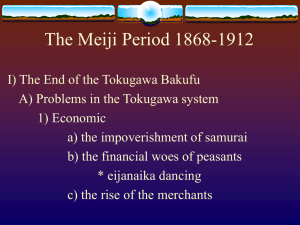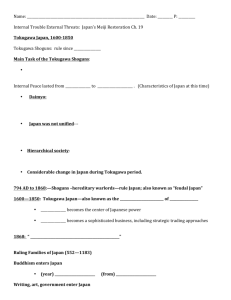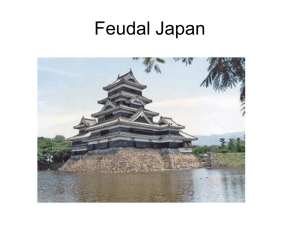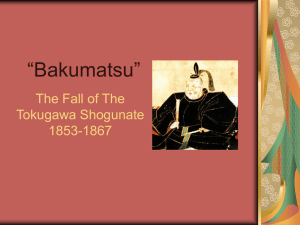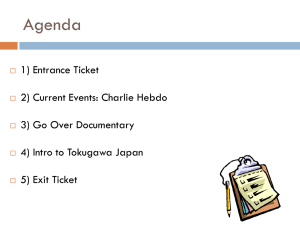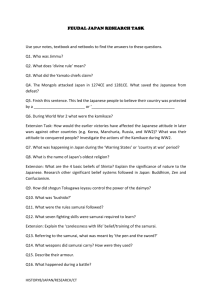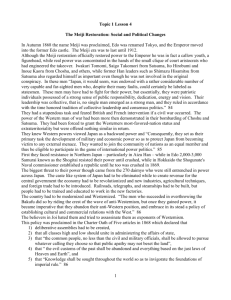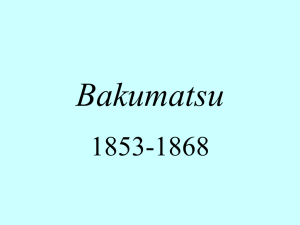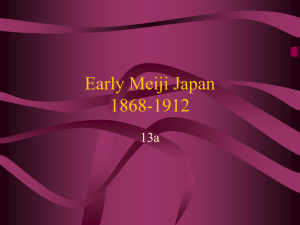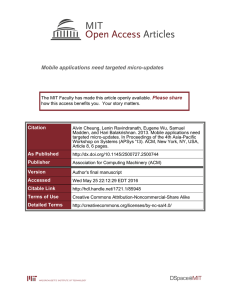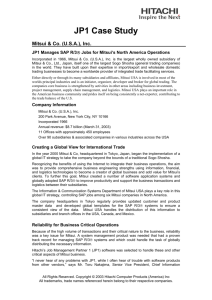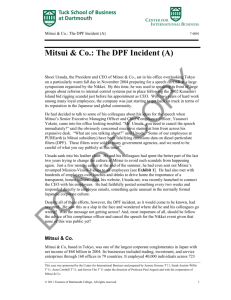topic 1 lesson 5 the meiji restoration legal and economic reforms
advertisement
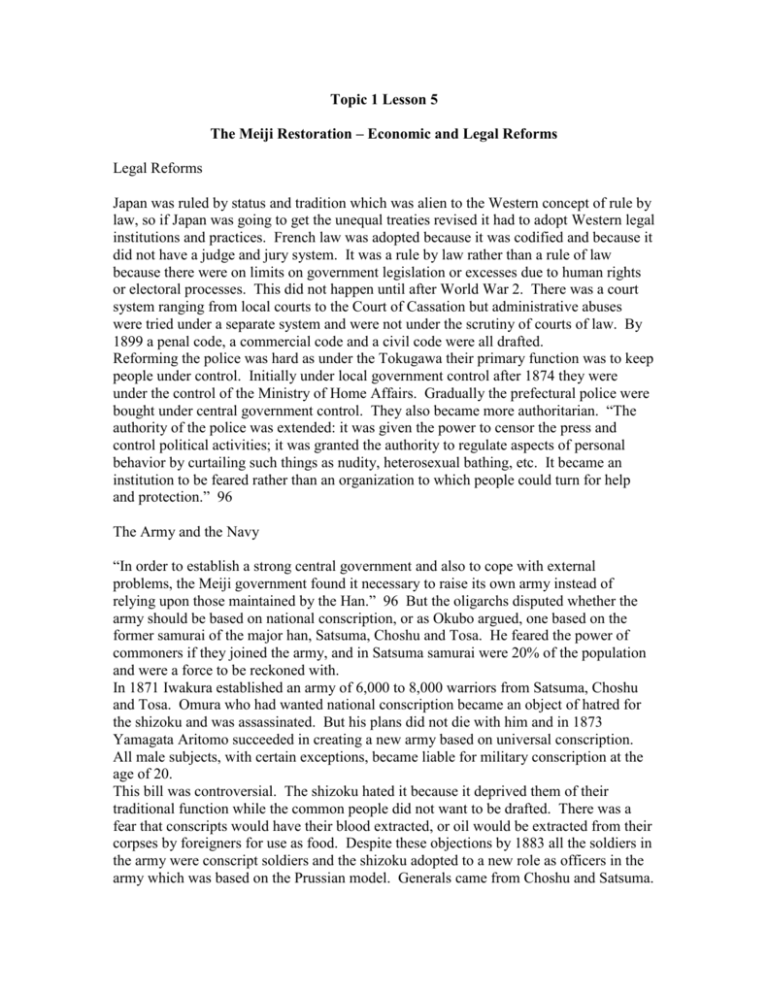
Topic 1 Lesson 5 The Meiji Restoration – Economic and Legal Reforms Legal Reforms Japan was ruled by status and tradition which was alien to the Western concept of rule by law, so if Japan was going to get the unequal treaties revised it had to adopt Western legal institutions and practices. French law was adopted because it was codified and because it did not have a judge and jury system. It was a rule by law rather than a rule of law because there were on limits on government legislation or excesses due to human rights or electoral processes. This did not happen until after World War 2. There was a court system ranging from local courts to the Court of Cassation but administrative abuses were tried under a separate system and were not under the scrutiny of courts of law. By 1899 a penal code, a commercial code and a civil code were all drafted. Reforming the police was hard as under the Tokugawa their primary function was to keep people under control. Initially under local government control after 1874 they were under the control of the Ministry of Home Affairs. Gradually the prefectural police were bought under central government control. They also became more authoritarian. “The authority of the police was extended: it was given the power to censor the press and control political activities; it was granted the authority to regulate aspects of personal behavior by curtailing such things as nudity, heterosexual bathing, etc. It became an institution to be feared rather than an organization to which people could turn for help and protection.” 96 The Army and the Navy “In order to establish a strong central government and also to cope with external problems, the Meiji government found it necessary to raise its own army instead of relying upon those maintained by the Han.” 96 But the oligarchs disputed whether the army should be based on national conscription, or as Okubo argued, one based on the former samurai of the major han, Satsuma, Choshu and Tosa. He feared the power of commoners if they joined the army, and in Satsuma samurai were 20% of the population and were a force to be reckoned with. In 1871 Iwakura established an army of 6,000 to 8,000 warriors from Satsuma, Choshu and Tosa. Omura who had wanted national conscription became an object of hatred for the shizoku and was assassinated. But his plans did not die with him and in 1873 Yamagata Aritomo succeeded in creating a new army based on universal conscription. All male subjects, with certain exceptions, became liable for military conscription at the age of 20. This bill was controversial. The shizoku hated it because it deprived them of their traditional function while the common people did not want to be drafted. There was a fear that conscripts would have their blood extracted, or oil would be extracted from their corpses by foreigners for use as food. Despite these objections by 1883 all the soldiers in the army were conscript soldiers and the shizoku adopted to a new role as officers in the army which was based on the Prussian model. Generals came from Choshu and Satsuma. The navy was based on the British model with officers from Satsuma. But it grew slowly. Only in 1875 did the navy buy three ironclad warships from England and as late as 1889 it still only had three iron, and three composite (iron and wood) ships. 97 These forces initially had no traditions or esprit de corps, so in 1882 an Imperial rescript was drafted emphasizing loyalty, duty, service, obedience, and valor. In particular it stressed “the special role they were to play as servants of the Emperor.” 97 Economic Developments Most importantly for the modernization of Japan was the creation of an economic revolution. There had to be “the application of modern scientific thought and technology to industry, transportation and agriculture”, increasing production per person and high population growth, rapid transformation of the industrial sector from agriculture to manufacturing, and international contacts. Ohkawa and Roscovsky see three stages of Japanese economic growth: the foundations from 1868 to 1885, initial growth from 1886 to 1905 continued growth from 1905 to 1952, and postwar growth from 1953 onwards. Tokugawa Japan despite the existence of some spinning mills and iron foundries was primarily agricultural. But it had potential. “ the Japanese economy and the 1860s was reasonably, but not outstandingly productive a traditional economy. It had a high potential to saving and was already showing signs of quickening economic growth. At the same time a number of other features make it more responsive than most traditional economies to economic stimuli. It was basically commercial with a well-developed system of national markets. The population was comparatively well educated and economically motivated. Because of efficient and productive taxation systems and its tradition of economic activity in control, government was well placed to play an important role in the process of economic modernisation.” 98 The Government had to reduce Tokugawa systems of control, abolishing samurai privileges, internal checkpoints obstructing trade and travel, and freedom of occupation was granted. The government fostered better agricultural techniques, the uniform land tax, a modern currency and banking system, and a public budget system. It also actively propagated Western knowledge and introduced public education. It built and operated tea Enterprises to encourage the development of new industries, constructing model planets, and granting government subsidies to private entrepreneurs. 98 the first railway line between Tokyo and Yokohama was opened in 1872, a telegraph line linking the two cities was opened in 1869, and a postal system linking Tokyo and Osaka was introduced in 1871. In shipping the government gave its support to Mitsubishi company to compete with foreign companies. By 1893 Japan had 2000 miles of railroad, 100,000 tonnes of steam vessels, and 4000 miles of telegraph lines. Shipyards, arsenals, foundries, machine shops and technical schools were established and operated with foreign technical advisers. The government backed the development of silk and cotton manufacture. It also supported the establishment of many new industries and of modern methods of mining particularly, for copper, coal, and precious metals. An industrial exposition was held in 1877, in the midst of the samurai rebellion. However, while the government played a very significant role in the industrialisation of Meiji Japan, it was not the only force that contributed to the transformation of the economy. Private enterprise played a key role and private savings accumulated. Rural leaders also helped introduce new agricultural knowledge into the villages. One key area of reform was in the fiscal realm. When the Meiji government came to power in 1868 it was in a very precarious financial situation. In 1872 total public expenditure is amounted to ¥148 million while revenue was only ¥50 million. The government borrowed money from big merchant houses in foreign nations. In 1872 it created national banks and retired the non-convertible notes it had issued, and in 1873 it instituted land tax. However its financial position was still strained, because much of the revenue it had raised was used to appeal the feudal obligations that it had inherited. In 1877 the situation got worse with the samurai rebellion and there was a real risk of inflation as the total amount of notes in circulation rose from 107 million in 1876 ¥165 million in 1879. As a result, the government's real income dropped drastically and it was forced to introduce new taxes on sake and tobacco, and reduce expenditure on developing new industries. In 1881 the new finance minister Masayoshi instituted a new policy of severe posterity, and deflation, reintroducing a convertible currency. New indirect taxes were introduced, public spending on costly factories and mines was reduced, and the state started redeeming public debts. The quantity of money was reduced by 20%, and by 1884 the general price level dropped to 75% of what it had been in 1881. "Matsukata thus restored the financial health of the government and gave the country a modern currency system and an effective budget structure. Japan was finally ready to enter the stage of modern economic growth." 100 Although this deflation was a great achievement, it faced a severe burden on the farmers, that ultimately led to agrarian riots. Taxes on satay and tobacco increased the burden on the common man more than the rich, while deflation was hard to farmers, because while prices for agricultural goods fell, the land tax rate remained the same. Between 1881 and 1884 the price of rice in Tokyo dropped 50% which meant that the peasants had to grow twice as much rice to meet their tax payments. Of particular interest was the growing cooperation between the new gigantic business houses, the zaibatsu, such as Mitsui, which had supplied the Imperial forces with funds, during their conflict with the Bakufu. The government helped them to form banks, and to expand into industry by transferring many state-owned enterprises to them at very low prices. In 1880 law was passed at enabling the government to transfer factories to private hands in non-strategic industries such as cotton spinning, glass making, and cement. Sumitomo, and Mitsui became powerful firms in this period. The government also supported and subsidised Mitsubishi in the area of shipping, giving it 13 ships that had been used as military transports during the Taiwan expedition of 1874, while helping expand its shipping business by giving it an annual subsidy of ¥250,000 for 15 years from 1875 onwards. In 1887 the Mitsubishi Co was helped even more when the government sold it the Nagasaki shipyards. Heads of the zaibatsu such as Mitsui and Mitsubishi, formed close contacts with the politicians sorry with key members of the government who were conducting these reforms. Inoue Kaoru was a close friend of the head of Mitsui, while the head of Mitsubishi, Iwasaki was a close friend of Okuma. The leaking of insider information on opponents bids strengthened their hands when bidding for government industries. 101
